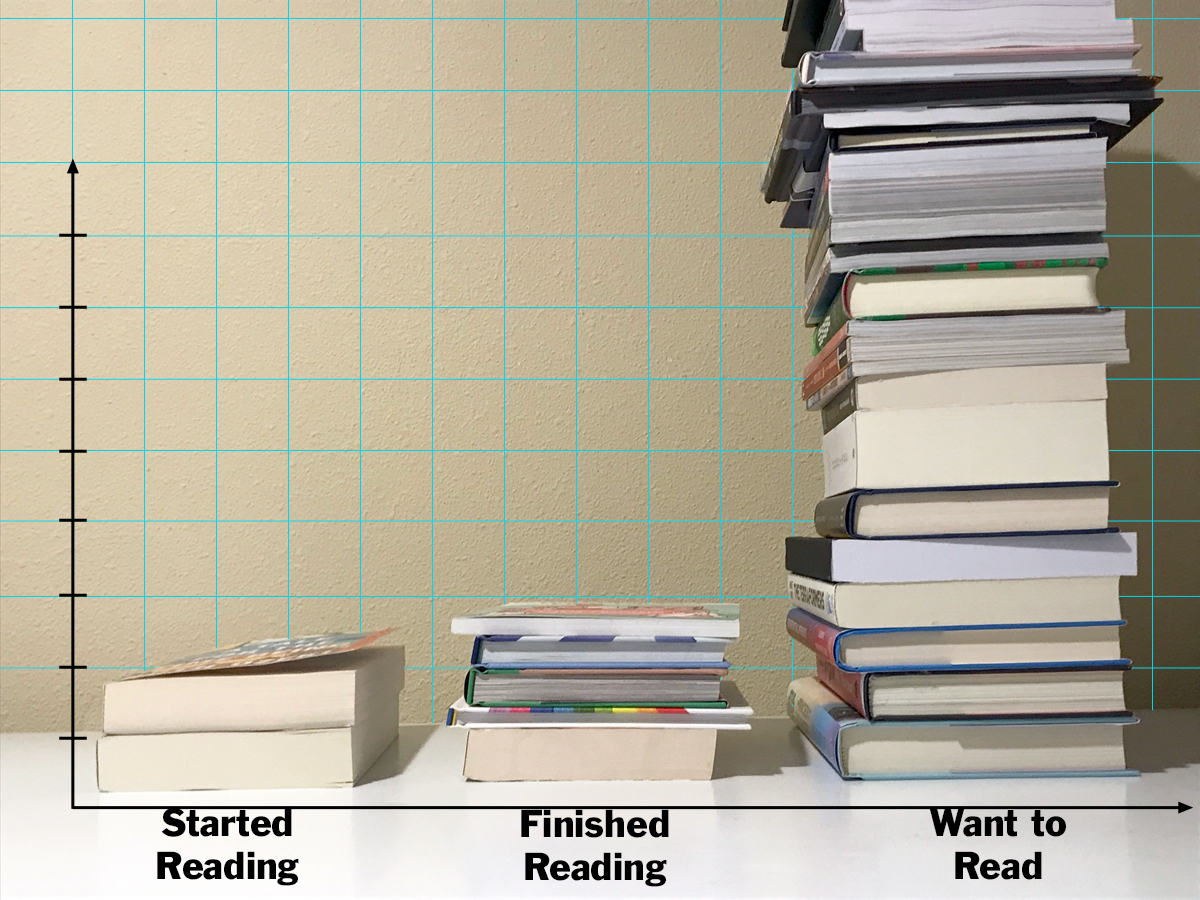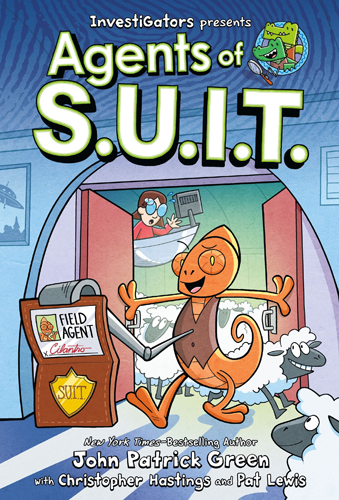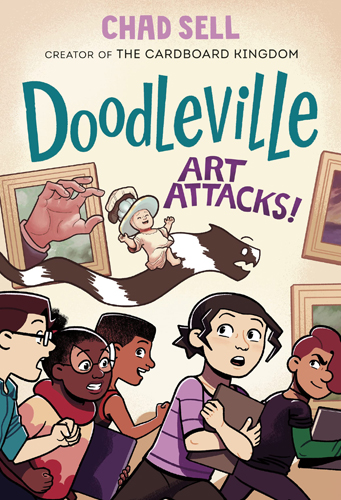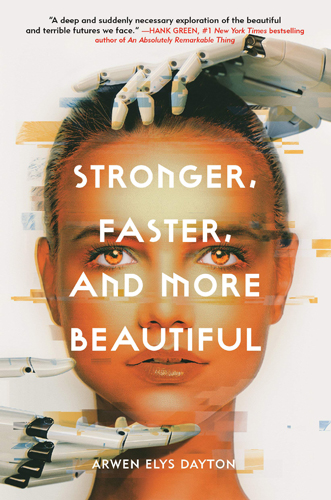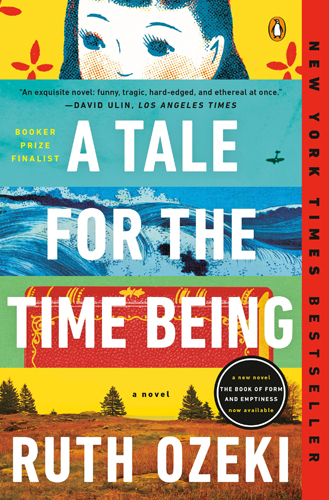I’ve missed a couple weeks here, in part because I just wasn’t finishing very many books. I did finish one book that I mentioned last time as well as a few comic books (a very small percentage of my stack), but the other two novels I started reading are just taking me longer to digest so far.
Let’s start with the comics!
Agents of S.U.I.T. by John Patrick Green
This book is a spin-off from the InvestiGators series, following some of the other characters—in this case, Cilantro the chameleon. She’s joined this team of secret agents, but she’s having trouble following some of the rules—specifically, the one that says she’s always supposed to be wearing her V.E.S.T. during a mission. The problem is that her camouflage only works on herself, so the vest gives away her position, but it also means she doesn’t have access to any gadgets or even handcuffs when she collars her first criminal.
So Cilantro is sent out to the field … literally. She and Agent Monocle are sent to a faraway cornfield with only a vague idea about what their mission is. They find an abandoned bunker base … but then what? Are they there to repair the base? Investigate the crop circles?
Like the InvestiGators books, this comic is filled with puns and goofy jokes, and my 9-year-old loves it. It’s fun to follow along with some of the other characters in this world—Mango and Brash show up briefly, but stop to make sure that the reader is following Cilantro instead of them. It looks like there will be more Agents of S.U.I.T. books coming soon, so we’re looking forward to them!
Doodleville: Art Attacks! by Chad Sell
This is a sequel to Doodleville (seen here), in which a young girl named Drew discovers that her drawings can come to life, sometimes with some unplanned results. She and her art club friends have a bit of a problem, though: her doodles have “borrowed” a baby from the art museum during a field trip in the last book. They come up with a plan to sneak the baby back into the museum, but instead end up setting off a war among various characters from paintings. The mother wants her child back, and suspects that Dorian Gray in another painting has something to do with it.
The kids each bring their superhero characters to help, but everyone has different ideas about the best approach. Ameer is sure that a good offense is what’s needed, but Zenobia is concerned for the collateral damage. TJ figures that chaos and magic can save the day, but Beck prefers things to be ordered and rational. It’s hard to find the common ground, but they need to figure things out before too much of the art is destroyed.
It’s fun to see characters from actual paintings (from the Art Institute of Chicago) brought to life, though the comic book version of Dorian Gray is not nearly as grotesque as the actual painting. This book gives each of the kids the spotlight for a time, showing us a bit more about who they are and how they think about things. If you enjoyed the first Doodleville, you’ll like revisiting the art club in this book.
Thor and Loki: Midgard Family Mayhem by Jeffrey Brown
Jeffrey Brown is known for his Darth Vader and Son series, which paints a funny picture of the Star Wars universe with many of the main characters as kids. Now he’s moved to the Marvel universe, with a book of comics featuring Thor and Loki (and several other siblings, as well as some of the Avengers) as kids. There are lots of hijinks involving Mjolnir, of course, and Loki has a lot of kid-sized tricks up his sleeves. It’s pretty cute, and I’m sure we’ll get to see more Marvel characters from Jeffrey Brown’s perspective in the future. Thor and Loki will be published next month.
Why Are You Like This? by Meg Adams
This hilarious autobiographical comic book shows scenes from the life of Meg, her husband Carson, and their dogs. Meg doesn’t take herself too seriously, and that’s to our benefit: her characters have rubber faces and can go from looking more normal to having totally stretched out grins or giant googly eyes depending on the situation. Both of them have their own obsessions, whether it’s overdecorating for Halloween or selecting watermelons at the grocery store, and Meg chronicles it all with a healthy dose of humor.
Stronger, Faster, and More Beautiful by Arwen Elys Dayton
I mentioned last time that I had started reading this one, which was published back in 2018. It’s more a series of stories rather than a novel, though they all take place in the same world, and the topic is about modifying humans. The first story begins “a few years from now” and each successive story takes us further into the future, with more and more capabilities to design and engineer who we are. Dayton imagines the way that the population could respond to these scientific advancements; in particular, there’s a character named Reverend Tadd who initially believes that some procedures are playing God and should not be performed, but over the course of a few stories has a major shift and becomes a prominent historical figure later on. While most of the stories take place in the United States, we do get a glimpse later on of how some other regions of the world handle human modification, and the ways that differing stances create rifts between nations.
The book is thought-provoking, and Dayton doesn’t seem to take a hard line either for or against the growing abilities to modify ourselves, but instead raises questions about how those abilities might be used, and who would choose to undergo more and more drastic changes. Is there a point at which we are no longer considered human, or is there no end to the ways that we could improve ourselves?
Hospital by Han Song
Here’s the first of the novels that I’ve started but haven’t finished yet, in part because it’s one that I need to take in small doses. Hospital was originally published in Chinese, and this edition was translated into English by Michael Berry, though he explains in an afterword that (due to some unexpected circumstances) he ended up working with Song during the translation and the book underwent significant changes, with entire sections added or removed as they discussed it.
The story follows a man named Yang Wei who falls ill soon after arriving in C City, and is taken to the hospital by the hotel staff. Once there, he becomes trapped in the dystopian labyrinth of the medical system, shuffled from department to department, undergoing endless tests, and subjected to long treatises about what it means to be a patient. It definitely has echoes of Kafka’s The Trial, with its main character lost in a system that never provides any direct answers. It seems like Yang Wei will never even get a diagnosis, but will instead spend the rest of his life navigating this bureaucratic nightmare.
The book has a dreamlike quality—in one instant, the narrator talks about how amazing and modern the hospital seems, and in the next we discover that things are decrepit and falling apart. He bounces back and forth between despair that he’ll never get better and glowing odes about finding his true purpose in being a patient. It reminds me a little of reading Jeff Vandermeer’s Southern Reach trilogy, the way that things are generally surreal and you never know what else might appear. There’s also a bizarre prologue about a mission to Mars in which the three travelers are there to search for the Buddha on Mars, but instead discover a strange structure … but I haven’t found out yet how this ties into Yang Wei’s story.
Although Hospital is written from a Chinese perspective, there are certainly parts of it that will be familiar to those who have had major medical issues in America as well. From trying to get an appointment to figuring out what insurance will cover to reaching a diagnosis for an uncommon ailment, the healthcare system can feel overwhelming and hostile, and this story captures that dread. That’s also why I’ve been reading it slowly, because it can be quite unpleasant, and I’m not anticipating that Yang Wei is going to have a happy ending. I also saw that Hospital is the first in a trilogy (the rest has already been published in China) so there’s a ways to go yet.
A Tale for the Time Being by Ruth Ozeki
Every year, Portland has an Everybody Reads program where they select a book and then have various programming around it. While I haven’t usually made it to the author talks or book clubs, I still enjoy that feeling of reading the same book as lots of other people in my community at the same time. I picked up a copy at the bookstore and have been reading this as well.
This book has two ongoing storylines. Ruth (definitely a stand-in for the author, as a lot of the character’s biographical details match what I’ve found about Ozeki herself) discovers a journal and some other items washed up on the beach. The journal was apparently written by a Nao, Japanese teenager who grew up in California but then moved back to Japan when her father lost his job. Her life in Japan hasn’t been great—her father is suicidal (and she may be as well), she is bullied at school, and she feels like she left her real life behind in California.
In the present day, Ruth pores over the journal and is trying to track down anything about Nao based on the details she finds—Nao’s great-grandmother Jiko was a nun at a Zen temple, and Nao shares some of the conversations she has with Jiko. We also get glimpses into Ruth’s life—she lives on a small island in Canada, and her discovery of the journal spreads quickly in the small town, much to Ruth’s chagrin. She feels a connection to Nao and would like to investigate more without everyone’s eyes on her.
I’m really enjoying the book so far—it has a strange feel to it because of Ruth’s self-insert, which makes me wonder how much of the parts about herself are true. It’s also the sort of novel that includes footnotes and even several appendices—translations of Japanese phrases, some thoughts about quantum mechanics or zen thought, and more.
My Current Stack
Well, that’s about it for this week! Although I didn’t finish more books, I did manage to do some culling of the growing piles of books on my office floor. I’d really love to get back to the stage where all of the books I have actually fit on the bookshelf, but there’s a long ways to go and I always feel bad getting rid of books I haven’t read. We were able to donate some books to a Children’s Book Bank event, and I may be able to send some to the elementary school for their library as well—and then maybe I’ll find some little free libraries to stock up!
Disclosure: I received review copies of the books included in this column except A Tale for the Time Being. Affiliate links to Bookshop.org help support my writing and independent booksellers!
